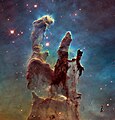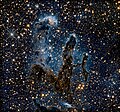English: These eerie, dark pillar-like structures are columns of cool interstellar hydrogen gas and dust that are also incubators for new stars. The pillars protrude from the interior wall of a dark molecular cloud like stalagmites from the floor of a cavern. They are part of the "Eagle Nebula" (also called M16 -- the 16th object in Charles Messier's 18th century catalog of "fuzzy" objects that aren't comets), a nearby star-forming region 7,000 light-years away in the constellation Serpens.
Ultraviolet light is responsible for illuminating the convoluted surfaces of the columns and the ghostly streamers of gas boiling away from their surfaces, producing the dramatic visual effects that highlight the three dimensional nature of the clouds.
The tallest pillar (left) is about a light-year long from base to tip. As the pillars themselves are slowly eroded away by the ultraviolet light, small globules of even denser gas buried within the pillars are uncovered. These globules have been dubbed "EGGs." EGGs is an acronym for "Evaporating Gaseous Globules," but it is also a word that describes what these objects are. Forming inside at least some of the EGGs are embryonic stars, stars that abruptly stop growing when the EGGs are uncovered and they are separated from the larger reservoir of gas from which they were drawing mass. Eventually, the stars themselves emerge from the EGGs as the EGGs themselves succumb to photoevaporation.
The picture was taken on April 1, 1995 with the Hubble Space Telescope Wide Field and Planetary Camera 2. The color image is constructed from three separate images taken in the light of emission from different types of atoms. Red shows emission from singly-ionized sulfur atoms. Green shows emission from hydrogen. Blue shows light emitted by doubly- ionized oxygen atoms.










